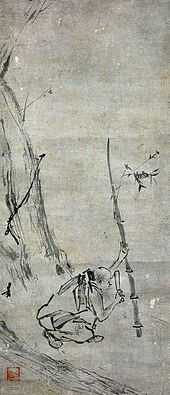Liang Kai
Liang Kai (Chinese: 梁楷; pinyin: Liáng Kǎi; c. 1140 - c. 1210) was a Chinese painter of the Southern Song Dynasty. He was also known as Madman Liang. He was born in Shandong and worked in Lin An (later Hangzhou).[1] He is known to have studied with the master Jia Shigu.[2]
He was awarded the rank of Painter-in-Attendance at the court of Jia Tai (1201-1204 CE, Southern Song Dynasty) where he was known for mastery in painting figures, landscapes, and other minor subjects.[1] He is most famous for originating or developing the "Xie Yi" (sometimes translated as "sketch style") of painting, where the objective is to evoke the subject or atmosphere with minimal use of detail; it requires a profound mastery of painting technique and perfect concentration, but also allows for the beauty of accidental effects.[3]
He left his position at court to practise Chan Buddhism. Xie Yi style is closely associated with the "sudden enlightenment", "mindfulness", and "spontaneity" aspects of this school of Buddhism.
Works generally attributed to Liáng Kǎi: painting of the poet Li Bai, the Drunken Celestial (aka A Sage), The Sixth Patriarch Cutting Bamboo, and in a more academic style, a series called the Eight Eminent Monks paintings.[1]
-

Li Bai Strolling
-

The Sixth Patriarch Cutting Bamboo
-

Drunken Celestial
-

Shakyamuni Emerging from the Mountains
References
- ↑ 1.0 1.1 1.2 Shen, Zhiyu (1981). The Shanghai Museum of Art. New York: Harry N. Abrams, Inc. pp. 223–224. ISBN 0-8109-1646-0.
- ↑ Loehr, Max (1980). The Great Painters of China. Oxford: Phaidon Press. pp. 215–216. ISBN 0-7148-2008-3.
- ↑ Kwo, Da-Wei (1981). Chinese Brushwork, Its History, Aesthetics, and Techniques. London: George Prior. pp. 103–104. ISBN 0-8390-0267-X.
| Wikimedia Commons has media related to Liang Kai. |